Related Research Articles

Major League Baseball (MLB) has been broadcast on American television since the 1950s, with initial broadcasts on the experimental station W2XBS, the predecessor of the modern WNBC in New York. The World Series was televised on a networked basis since 1947, with regular season games broadcast nationally since 1953. Over the forthcoming years, MLB games became major attractions for American television networks, and each of the Big Three networks would air packages of baseball games at various times until the year 2000. Fox would rise to major network status, partially on its acquisition of MLB rights in 1996; Fox has been MLB's primary broadcast television partner ever since.
ESPN on ABC is the branding used for sports event and documentary programming televised by the American Broadcasting Company (ABC) in the United States. Officially, the broadcast network retains its own sports division; however, in 2006, ABC's sports division was merged into ESPN Inc., which is the parent subsidiary of the cable sports network ESPN that is majority owned by ABC's corporate parent, The Walt Disney Company, in partnership with Hearst Communications.

NBC Sports is an American programming division of the broadcast network NBC, owned and operated by the NBC Sports Group division of NBCUniversal and subsidiary of Comcast. The division is responsible for sports broadcasts on the network, and its dedicated national sports cable channels. Formerly operating as "a service of NBC News", it broadcasts a diverse array of sports events, including Major League Baseball, the French Open, the Premier League, the IndyCar Series, NASCAR, the National Football League (NFL), Notre Dame Fighting Irish college football, the Olympic Games, professional golf, the Tour de France and Thoroughbred racing, among others. Other programming from outside producers – such as coverage of the Ironman Triathlon – is also presented on the network through NBC Sports. With Comcast's acquisition of NBCUniversal in 2011, its own cable sports networks were aligned with NBC Sports into a part of the division known as the NBC Sports Group.
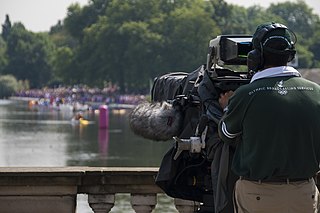
The broadcasting of sports events is the live coverage of sports as a television program, on radio, and other broadcasting media. It usually involves one and more sports commentators describing events as they happen.
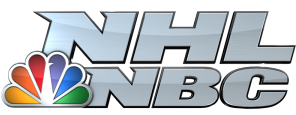
The NHL on NBC is an American presentation of National Hockey League (NHL) games produced by NBC Sports, and televised on NBC properties, including MSNBC, CNBC, Golf Channel, USA Network and NBCSN in the United States.
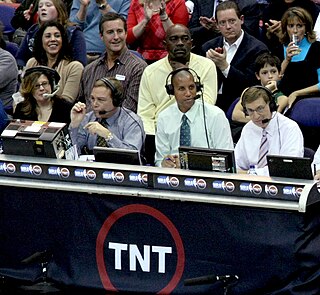
National Basketball Association (NBA) games are televised nationally in the United States, as well as on multiple local channels and regional sports networks. Since the 2002–03 season, broadcast channel ABC, and pay TV networks ESPN and TNT have nationally televised games. Throughout most of the regular season, ESPN shows doubleheaders on Wednesday and Friday nights, while TNT shows doubleheaders on Tuesday and Thursday nights. In the second half of the season, ABC shows a single game on Saturday nights and Sunday afternoons. Games are shown almost every night on NBA TV. There are some exceptions to this schedule, including Tip-off Week, Christmas Day, and Martin Luther King Jr. Day. More games may be shown as the end of the regular season approaches, particularly games with playoff significance. During the playoffs, the first round are split between TNT, ESPN, NBA TV, and ABC on mostly weekends the second round are split between ESPN, TNT and ABC on weekends. The conference finals are split between ESPN/ABC and TNT; the two networks alternate which complete series they will carry from year to year. The entire NBA Finals is shown nationally on ABC. The NBA Finals is one of the few sporting events to be shown on a national broadcast network on a weeknight.

USA Network Thursday Night Baseball aired Major League Baseball (MLB) games on the USA Network from 1979 to 1983.

The NHL on USA was the de facto title of a television show that broadcast National Hockey League games on the USA Network.
The NBA on USA is the de facto name for the USA Network's National Basketball Association (NBA) television coverage. The program ran from the 1979–80 season through the 1983–84 season.
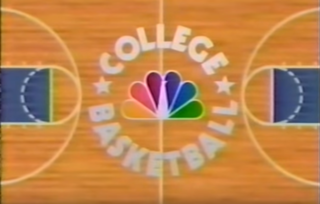
College Basketball on NBC Sports is the de facto branding used for broadcasts of NCAA Division I men's college basketball games produced by NBC Sports, the sports division of the NBC television network in the United States. The NBC network broadcast college basketball games in some shape or form between 1969 and 1998. From 1969 to 1981, NBC covered the NCAA Division I men's basketball tournament. It became the first major network to broadcast the championship game, at a cost of more than US$500,000 in 1969.
In the United States, sports are televised on various broadcast networks, national and specialty sports cable channels, and regional sports networks. U.S. sports rights are estimated to be worth a total of $22.42 billion in 2019, about 44 percent of the total worldwide sports media market. U.S. networks are willing to pay a significant amount of money for television sports contracts because it attracts large amounts of viewership; live sport broadcasts accounted for 44 of the 50 list of most watched television broadcasts in the United States in 2016.
The National Hockey League has never fared as well on American television in comparison to the National Basketball Association, Major League Baseball, or the National Football League, although that has begun to change, with NBC's broadcasts of the final games of the 2009, 2010, 2011, and 2013 Stanley Cup Finals scoring some of the best ratings ever enjoyed by the sport on American television.
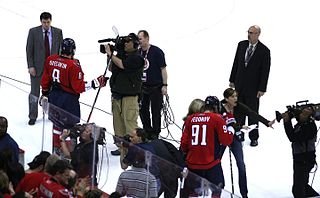
The National Hockey League (NHL) is shown on national television in the United States and Canada. With 25 teams in the U.S. and 7 in Canada, the NHL is the only one of the four major professional sports leagues in the United States and Canada that maintains separate national broadcasters in each country, each producing separate telecasts of a slate of regular season games, playoff games, and the Stanley Cup Finals.
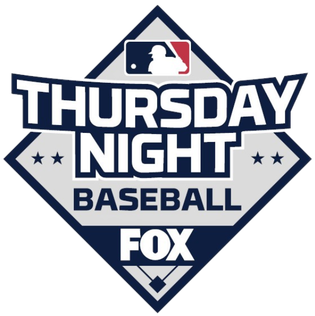
Thursday Night Baseball is the de facto branding used for live game telecasts of Major League Baseball on Thursday nights.
During the 1979–80 and 1980–81 seasons, four more Canadian teams, the Edmonton Oilers, Quebec Nordiques, Winnipeg Jets, and Calgary Flames, joined the NHL. The Oilers and Flames were featured frequently as the two teams were contenders the 1980s; in contrast, as the Nordiques were owned by Carling-O'Keefe, a rival to the show's sponsor Molson and whose English-speaking fanbase was very small, the Nords were rarely broadcast, and never from Quebec City during the regular-season.
After Wayne Gretzky was traded to the Los Angeles Kings in 1988, CBC began showing occasional double-headers when Canadian teams visited Los Angeles to showcase the sport's most popular player. These games were often joined in progress, as the regular start time for Hockey Night in Canada was still 8 p.m. Eastern Time and the Kings home games began at 7:30 p.m. Pacific Time. Beginning in the 1995 season, weekly double-headers became permanent, with games starting at 7:30 Eastern and 7:30 Pacific, respectively. In 1998, the start times were moved ahead to 7 p.m. ET and PT.
Sports programming on the American Broadcasting Company is provided on occasion, primarily on weekend afternoons; since 2006, the ABC Sports division has been defunct, with all sports telecasts on ABC being produced in association with sister cable network ESPN under the branding ESPN on ABC. While ABC has, in the past, aired notable sporting events such as the NFL's Monday Night Football, and various college football bowl games, general industry trends and changes in rights have prompted reductions in sports broadcasts on broadcast television.
The National Hockey League (NHL) is shown on national television in the United States and Canada. With 25 teams in the U.S. and 7 in Canada, the NHL is the only one of the four major professional sports leagues in the United States and Canada that maintains separate national broadcasters in each country, each producing separate telecasts of a slate of regular season games, playoff games, and the Stanley Cup Finals.
References
- ↑ Cable television regulation: hearings before the Subcommittee on Telecommunications and Finance of the Committee on Energy and Commerce, House of Representatives, One Hundred First Congress, second session, Volume 2. 1990. p. 82.
- ↑ Anderson, Dave (December 30, 1979). "'I'll set women's tennis back 20 years'; Champs Come and Go; TV's Forever". New York Times. p. DX8.
- ↑ Shea, Stuart (7 May 2015). Calling the Game: Baseball Broadcasting from 1920 to the Present. SABR, Inc. p. 373. ISBN 9781933599410.
- ↑ "Big-League Baseball To Hit Hinterlands On Cable Television". Wall Street Journal. April 13, 1979.
- ↑ "Majors give cable rights". Lawrence Journal-World. April 13, 1979.
- ↑ Jane Gross (July 12, 1981). "Sports on cable". The New York Times .
USA agreed to the baseball limitations rejected by ESPN and shows a Thursday-night game in cities that do not have a major-league team. In New York City, Manhattan Cable broadcasts USA's programs, but cannot televise the weekly baseball game because the Yankees and Mets declined to grant the waivers necessary under major-league statutes.
- ↑ Jicha, Jim (April 3, 1982). "Is The Chance To .Ao To The Park ". Miami News. Archived from the original on July 12, 2012.
- ↑ "Giants Announce Signings of Stennett, May, Wohlford". Los Angeles Times. December 13, 1979.
- ↑ "Philadelphia Daily News : BASEBALL SWINGS AN UNREAL DEAL". Philadelphia Daily News. March 1, 1983.
- ↑ "USA NETWORK MAKING SOME MAJOR-LEAGUE CUTS". Miami Herald. February 10, 1984.
- ↑ 1982 08 18 Tulsa Roughnecks at New York Cosmos on YouTube
- ↑ USA Network Sports Promos (Mar. 8, 1983) on YouTube
- ↑ USA sports promo, 1983 on YouTube
- ↑ USA Network College Basketball Utep vs Wyoming Commercial 1988 on YouTube
- ↑ Wall, Kevin M. (April 12, 2016). "Pearl Washington: An Inspiration On and Off the Court". Nunes Magician.
- ↑ CGI History - 1987 USA Sports Basketball - Ed Kramer, CGI Expert Wizard on YouTube
- ↑ Klatell, Marcus, David A., Norman (1988). Sports for sale: television, money, and the fans. Oxford University Press. p. 58. ISBN 9780195038361.
{{cite book}}: CS1 maint: multiple names: authors list (link) - ↑ December 11, 1984 Commercial Breaks 📺 USA Network on YouTube
- ↑ USA Network 1987 commercials on YouTube
- ↑ Feb 14, 1982 - The 1979— Daytona 500 was a classic race, and it happened to be the first one televised live, start to finish, by The network could hardly ... and made a deal with the USA cable network to furnish the qualifiers for cablecasting Fri day night. doing this, in effect, satisfies the inter ...
- ↑ Feb 16, 1984 - The trucks which pulled Into Daytona International Speedway last week were all not necessarily those containing the cars of the NASCAR drivers ... The USA Network will show the two 125 mile qualifying races Friday night at 8 but that Is under an agreement where the cable network ...
- ↑ Mar 29, 1982 - ... ... th Nabisco Dinah Shore Invitational Sports has signed a pact with video evangelist Pat Robertson's Christian Broadcast Network for the Dinah ... the right to tape them for replay later which has been in the business of cable since it split coverage of the Daytona 500 with USA Cable ...
- ↑ Apr 10, 1982 - an undisclosed fee for two days of broadcast rights USA had so little to do with the telecasts that it had just one of its own people on air ... as he stated it has worked Ratings for the Daytona 500 improved Bait the viewer with cable hook him with the network broadcast not saying I ...
- ↑ Ratings For Each Round of The Masters Since '82 (First/Second Rounds Since '99)
- ↑ "History of the Masters golf tournament on TV (1956-present)". Classic Sports TV and Media. 9 April 2013. Retrieved 13 April 2013.
- ↑ USA sports promo, 1984 on YouTube
- ↑ Pearl Washington's Half-Court Buzzer-Beater (1984) | Great Moments in Syracuse University Sports on YouTube
- ↑ Pearl Washington's greatest shot ever against Boston College 1/21/84 on YouTube
- ↑ "US Open's cable TV deal leaves USA Network for ESPN". New York Daily News. May 12, 2008.
- ↑ Strachan, Al (July 30, 1985). "ESPN acquires NHL games Backroom bickering in TV deal". The Globe and Mail.
- ↑ Mulligan, Kevin (July 26, 1985). "NHL Finds a Home at ESPN". Philadelphia Daily News.
- ↑ Pruett, Marshall (20 July 2021). "IndyCar, NBC confirm multi-year extension". Racer . Retrieved 24 September 2021.
- 1 2 "NTT IndyCar Series announces 17-race schedule for 2022". Racer. 19 September 2021. Retrieved 24 September 2021.
- ↑ "NBC Sports Announces 2022 Nascar Telecast Schedule". 2 November 2021.